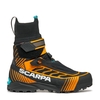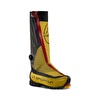Annapurna, successful and failed rescues
Three alpinists weere airlifted to safety by helicopter from an altitude of 6950m on Annapurna yesterday, while Spanish mountaineer Tolo Calafat passed away.

 1 / 1
1 / 1
Annapurna, helicopter resuce
 Air Zermatt
Air Zermatt
Tolo Calafat unfortunately didn't make it. The Spanish mountaineer died yesterday at circa 7600m on Annapurna after having reached the summit on 27 April. This is an immense loss for the family of the 44-year-old and our thoughts go out to his relatives. In the meantime the mountain is shrouded in a cloud of bitter polemics about the ascents and the attempt, or failed attempt, to save Calafat's life.
While this is no doubt tragic, it is worth mentioning that yesterday three alpinists were airlifted to safety from almost 7000m on Annapurna. Three lives saved, which must be added to the seven alpinists belonging to a Korean expedition evacuated just a few days ago from Camp 2 at circa 6500m on Manaslu. It goes without saying that this is a truly extraordinary feat.
These recent rescue missions have been carried out thanks to a recent agreement reached by Nepalese pilots and Air Zermatt, who this summer provided the necessary logistics and training for these rescue operations which require the utmost ability and preparation. A helicopter rescue with the use of a longline in the Alps is always a delicate affair and the difficulties in the Himalaya, at 6950m, become nigh impossible.
It's clear that the new boundaries helicopter rescues at altitudes previously believed to be impossible will bring about change, just as it did with the systematic implementation of helicopter rescues in the Alps. How and when this evolution will unfold is difficult to say, also because the level of danger at these altitudes is extremely high. What is certain however is that these recent changes will considerably alter Himalayan mountaineering. Change is not necessarily always something good or bad. As usual it will depend on how alpinists and alpinism evolve compared to what can undoubtedly be described as progress.
29.04.2010 Sling rescue at 6950 meter at Annapurna
On April 29th the newly formed helicopter rescue team of Nepalese Fishtail Air and Swiss Air Zermatt, evacuated three climbers from 6950 meters on Annapurna in Nepal.
The rescue team of Fishtail/Air Zermatt was asked yesterday morning to come to Annapurna where a Spanish expedition was in need. One climber was completely exhausted after summiting the 8091 meter peak. He said he was snowblind and could not move hands or legs. It was not clear at what altitude he was located.
The rescue team immediately started the mission from Kathmandu but because of bad weather they could not reach Annapurna base camp They flew to Pokhara and spent the night there. The next morning at 6.00am the team started again and they flew to BC without any problems. After a short meeting with the Spanish expedition leader it became clear that the missing climber was at around 7500 meter altitude. He was not answering the radio anymore. One Sherpa started in the night from Camp 4 to try to reach the climber in need. In Camp 4 (at 6950 meter altitude) there were three other climbers of the Spanish team, said to be suffering from High Altitude Sickness and frostbite.
In a reconnaissance flight, carried out by pilots Sabin Basnyat and Dani Aufdenblatten and a expedition doctor, the team discovered that the climber was dead. The three Spanish climbers in Camp 4 where evacuated with a sling operation. One by one they were flown down to base camp at 4000 meters.
The Sherpa who went up in the night returned safely back to Camp 4 but did not want to be rescued by helicopter. He walked down by himself.
Menno Boermans, Air Zermatt Switzerland
While this is no doubt tragic, it is worth mentioning that yesterday three alpinists were airlifted to safety from almost 7000m on Annapurna. Three lives saved, which must be added to the seven alpinists belonging to a Korean expedition evacuated just a few days ago from Camp 2 at circa 6500m on Manaslu. It goes without saying that this is a truly extraordinary feat.
These recent rescue missions have been carried out thanks to a recent agreement reached by Nepalese pilots and Air Zermatt, who this summer provided the necessary logistics and training for these rescue operations which require the utmost ability and preparation. A helicopter rescue with the use of a longline in the Alps is always a delicate affair and the difficulties in the Himalaya, at 6950m, become nigh impossible.
It's clear that the new boundaries helicopter rescues at altitudes previously believed to be impossible will bring about change, just as it did with the systematic implementation of helicopter rescues in the Alps. How and when this evolution will unfold is difficult to say, also because the level of danger at these altitudes is extremely high. What is certain however is that these recent changes will considerably alter Himalayan mountaineering. Change is not necessarily always something good or bad. As usual it will depend on how alpinists and alpinism evolve compared to what can undoubtedly be described as progress.
29.04.2010 Sling rescue at 6950 meter at Annapurna
On April 29th the newly formed helicopter rescue team of Nepalese Fishtail Air and Swiss Air Zermatt, evacuated three climbers from 6950 meters on Annapurna in Nepal.
The rescue team of Fishtail/Air Zermatt was asked yesterday morning to come to Annapurna where a Spanish expedition was in need. One climber was completely exhausted after summiting the 8091 meter peak. He said he was snowblind and could not move hands or legs. It was not clear at what altitude he was located.
The rescue team immediately started the mission from Kathmandu but because of bad weather they could not reach Annapurna base camp They flew to Pokhara and spent the night there. The next morning at 6.00am the team started again and they flew to BC without any problems. After a short meeting with the Spanish expedition leader it became clear that the missing climber was at around 7500 meter altitude. He was not answering the radio anymore. One Sherpa started in the night from Camp 4 to try to reach the climber in need. In Camp 4 (at 6950 meter altitude) there were three other climbers of the Spanish team, said to be suffering from High Altitude Sickness and frostbite.
In a reconnaissance flight, carried out by pilots Sabin Basnyat and Dani Aufdenblatten and a expedition doctor, the team discovered that the climber was dead. The three Spanish climbers in Camp 4 where evacuated with a sling operation. One by one they were flown down to base camp at 4000 meters.
The Sherpa who went up in the night returned safely back to Camp 4 but did not want to be rescued by helicopter. He walked down by himself.
Menno Boermans, Air Zermatt Switzerland
Note:
| Links Planetmountain | |
| News Annapurna | |
| Links www | |
| www.air-zermatt.ch | |
Latest news
Expo / News
Expo / Products
The Zenith is a mountaineering axe that uniquely combines lightweight design with technical features for top-level performance.
Revolutionary fast & light mountaineering boot SCARPA RIBELLE TECH 3 HD, with superior waterproof and breathable protection thanks to HDry technology.
Technical footwear for high altitude mountaineering and ice climbing.
The world’s lightest – and most technically advanced – high altitude mountaineering boots.
Ever since its market launch, the Barryvox avalanche transceiver has been among the most reliable transceivers in the world.
Petzl Irvis Hybrid crampons for ski touring and approaches involving glacier travel.



 Copia link
Copia link























